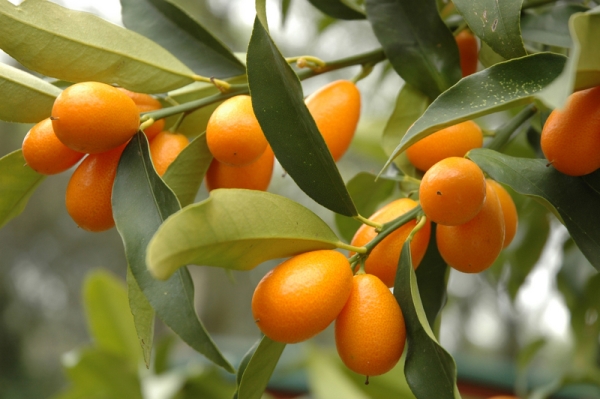The Chinese chronicles of the 11th century, unusual for Europeans, are mentioned for the first time. Portuguese mariners brought a strange citrus, which only in the middle of the 19th century described the Scottish botanist. His name was the name of a whole family of tropical plants - Fortunella, officially recognized by nerds only in the early twentieth century.
Originally from Indochina, kumquat (in Cantonese dialect it is a golden orange) differs from oranges not only externally - the sweet peel hides the core with a sour taste.
Table of contents
What is a kumquat and how does it look, can it be eaten?
This is a short tree or shrub with a spherical crown. Can grow to 3-4 meters tall. It does not belong to long-livers - life expectancy is no more than 40 years. The plant loves bright diffused light. Prefers fertile sandy soil. Like all citrus fruits, it can grow in fairly dry areas - the need for water is quite moderate.
Propagated by seeds and vegetatively - cuttings, grafting, layering. Nowadays, this miracle of nature grows only in Indochina and Japan - its industrial plantings are developing in the Middle East, Florida, and the Mediterranean. Wet subtropics are the favorite climate of this fruit.
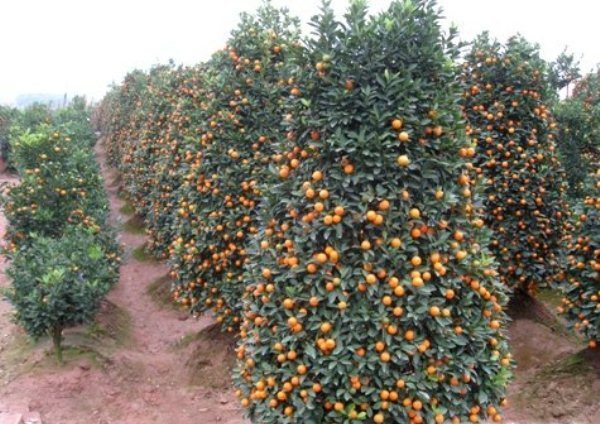
Temperature 25-30aboutWITH, along with high humidity - the most comfortable for him. With a lack of water and with a higher thermometer, kumquat leaves leaves. Often grown as an ornamental plant open ground and indoor.
It grows very ornamental evergreen shrub or tree first with fragrantlarge flowers, and then - strewn with oval fruits. Up to 5 cm long, they look like miniature oranges.
Unlike its namesake, “golden orange” has only 4-7 cloves. Sweet and sour pulp contains about 5 seeds (by the number of lobes). The main difference from all citrus fruits is that it is eaten with the skin, it has a delicate, sweet taste.
It turns out that the sweetest skin of a wild-growing kumquat comes from Hong Kong.
Its fruits ripen on New Year's holidays, like all citrus fruits of our hemisphere. All varieties have a bountiful harvest.

It has already been said that Kumquat is a resident of the subtropics and tropics. Attempts to forcibly resettle him to the north failed. It turned out that its cuttings had taken root on the deciduous shrub “Poncirus”. On such a stock, the kumquat can stand frost -10-15aboutWITH.
The fruits of this plant are not as sweet as in the tropics, but this does not stop gardeners - the work of breeders is not over.
Calorie and composition
Given the high percentage of water concentration (up to 80), kumquat has a very low calorie content - 71 kcal / 100 grams. However, during drying, the caloric content increases to 250 kcal / 100g.
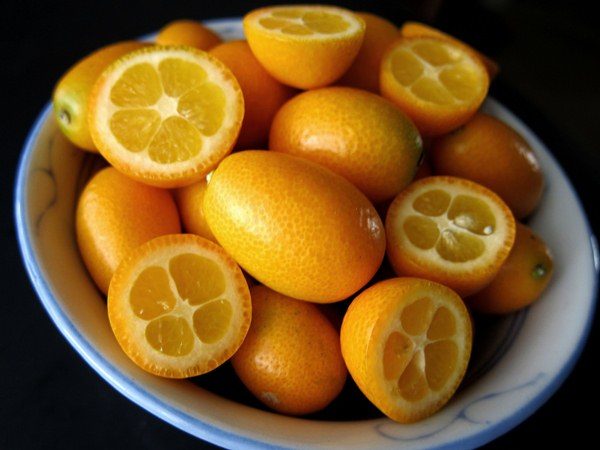
The list of vitamins present is headed by ascorbic acid. In addition to vitamin C, kinkan is rich in vitamins A, E, B3 and B5.
Recommendations to use the fruit along with the peel did not appear on level ground - it is the thin, delicate skin that is rich in trace elements and minerals. The composition of the fruit is characterized by a high content of potassium (regulates the heart rhythm), calcium, sodium, magnesium, micro-doses of zinc and iron. Essential oils, monosaccharides and polyunsaturated fatty acids add to kumquat popularity as a valuable dietary product.
Kumquat fruits are very useful, as they absolutely do not absorb nitrates from the soil. This is a completely unique property for the current environmental situation is very important.
Useful properties of this fruit and harm to the human body
Chinese traditional medicine has long used the bactericidal properties of kumquat. Even now, the juice of these fruits suppress the development of internal and external infections, respiratory diseases. Kumquat oil inhalation is one of the best ways to prevent this disease during a flu epidemic., to alleviate the condition with a dry agonizing cough, chronic rhinitis.
The unusually high content of ascorbic acid removes the body from a hangover, fresh intake of several fruits helps to quickly get out of abstinence. It is enough just to chew a few dried fruits - the effect is noticeable after a few minutes.

Regular consumption of “golden orange” normalizes immunity, although this property is inherent in all citrus fruits. In the treatment of skin diseases, kumquat essential oil is often used.. Its composition has a tonic effect on the human as a whole, and especially on the liver and gallbladder - helps break down fats.
Kinkana oil is successfully used in cosmetology for spa procedures, and a combination with oils of other plants successfully treat problem skin. Interestingly, regular procedures with the oil of this fruit relieve postpartum stretch marks, as well as cellulite.
In aromatherapy the essential oil of this citrus is used to treat stress, as well as sleep disorders. Instead of an aroma lamp, you can put the peel pieces on heat radiators - ensure a healthy sleep and disinfect the room.
From traditional Chinese medicine in the usual practice included use of tincture of kinkan with honey, which quickly reduces the level of harmful cholesterol, normalizes heart rhythm.
As a low-calorie product, kumquat has been used in weight control diets.. But this applies only to fresh fruit - the calorie content of fruits increases many times during processing and drying.
Contraindications for use
With the benefits that this fruit can bring to human health, we understand, now let's talk about the possible harm. Unfortunately, citrus intolerance is quite common. If you are prone to various allergies, do not take risks - eat more than two fruits at a time.
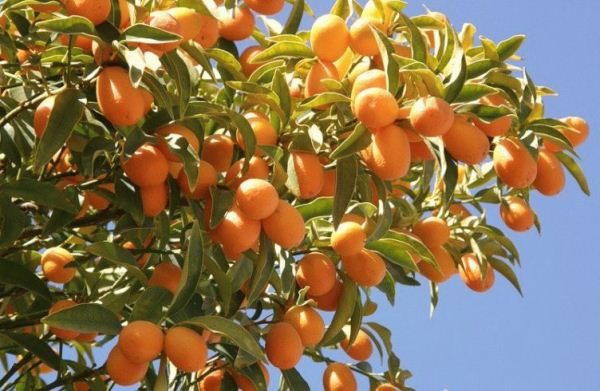
If you are trying a new fruit for the first time, limit yourself to half for the first time.. Trace the state of the body.The portion can be increased if unpleasant consequences are not observed.
Pregnant women are not prohibited by kumquat, only the special susceptibility of the woman’s body and the fetus to a possible change in the diet should be taken into account. Practice shows that this citrus copes with early toxicosis. Doctors are usually limited to general recommendations - “not to abuse”.
It is clear that due to the high content of organic acids, this citrus is not recommended for gastroenterologist patients. Contraindications are also diseases of the kidneys and urinary organs.. Regarding diabetics, they should also be careful to use only fresh fruit with constant monitoring of sugar level.
Recipes blanks from kumquat
The use of kumquat is completely universal.:
- they are eaten fresh (with skin),
- in medical recommendations,
- in cosmetology,
- in cooking.
In cooking alone, its use is not limited to the preparation of refreshing beverages, both non-alcoholic and alcoholic. As an ingredient, kumquat fruits are often added to meat, sauces and various salads..
Often it is added to dairy products - curd mass, yogurt.
but The main use of fruit is for the preparation of desserts and sweets.. From these fruits turn out preparations which are perfectly stored all winter, - candied fruits. confitures, jam, marshmallow.
In fresh and dried form, kumquat is added to the recipe of baked pastry.
Kumquat jam
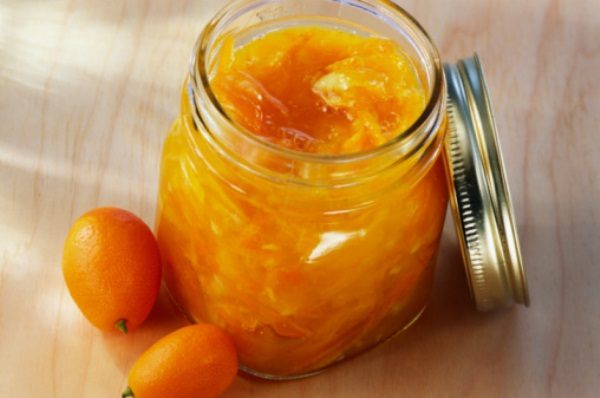
Will need:
- fresh fruit - 1 kilogram,
- granulated sugar - 1 kilogram,
- 1 lemon juice
Cooking
- Slightly notch the fruit, blanch them in three waters.
- From the glass of the last broth, cook syrup from whole sugar.
- Put the kumquats in hot syrup and reduce them until thick.
- Shortly before the readiness to add lemon juice.
- After cooling, place the jam in sterile jars.
Fresh Kumquat Jam

Will need:
- kumquat fruits - 1 kilogram,
- granulated sugar of 1-1.2 kilograms
- 1 lemon juice,
- vanilla sugar - 1 bag.
Cooking
- Punish washed fruits (for example, with a fork) and boil for 10 minutes, cool with cold water.
- In a glass of water (the remainder of blanching) dissolve half of all sugar.
- In this syrup put the fruit, bring to a boil and cook for 5 minutes.
- When the semi-finished product has cooled, add some more sugar and boil it again for several minutes.
- The third time, add the remaining sugar and bring to readiness - the fruits should become translucent.
- Just before the end - add lemon juice and vanilla sugar.
- Hot lay on sterile jars and twist the lids.
Dried fruits: candied
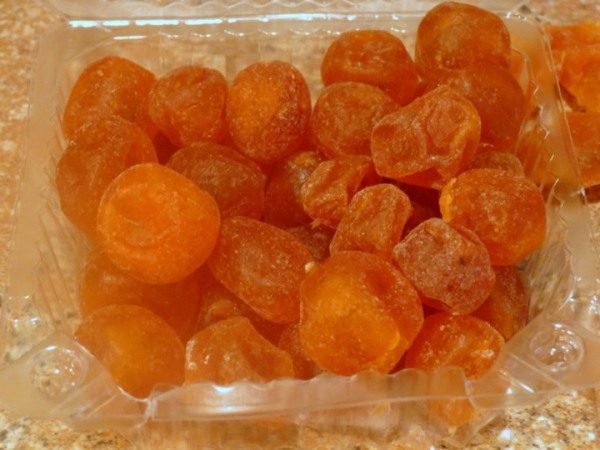
If jam is cooked without pre-boiling, the fruits do not boil dry and will be strong. After completion of cooking, fold everything into a colander and then spread out in a single layer, then on a flat dish for drying.
Conclusion
Here it is such a “golden orange” from Indochina by birth, about which Europe learned not so long ago. And now its landings have already conquered the Middle East, the Mediterranean coast, and California. In the tub culture, kumquat grows not only in winter gardens and greenhouses, but also in the conditions of a city apartment. A low evergreen tree with fragrant flowers and elegant fruits is a living corner of subtropics in the walls of a high-rise building ...
